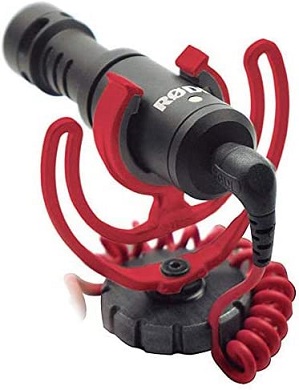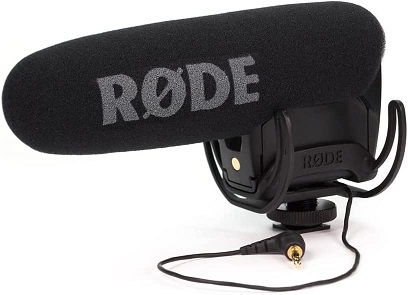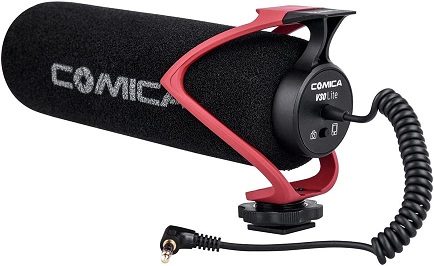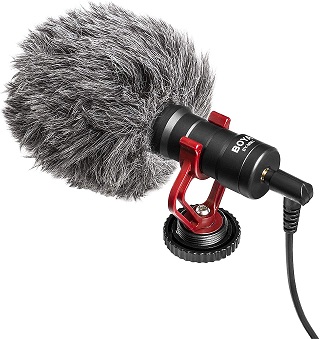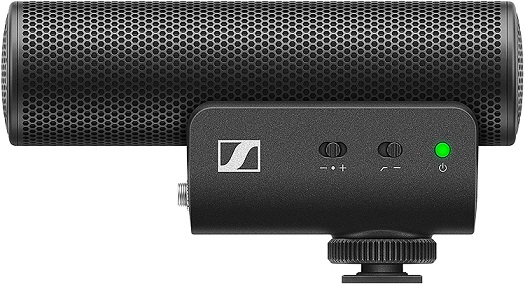On-camera microphones are designed to mount directly on DSLR cameras, mirrorless systems, or smartphones, these mics offer improved sound capture over built-in camera microphones. They are ideal for vloggers who require clear, crisp audio in various environments, from quiet indoor spaces to noisy outdoor settings.
Key Factors To Consider:
- Polar Pattern: Understanding the importance of how a microphone captures sound in different environments, we’ve considered microphones with various polar patterns. Whether it’s cardioid for direct sound, super-cardioid for more focused pickup, or omnidirectional for capturing ambient sounds, the selected mics excel in their respective categories.
- Compatibility: Our list includes microphones that are universally compatible with DSLRs, mirrorless cameras, and even smartphones, ensuring that no matter your gear, there’s a high-quality audio solution available.
- Audio Quality: We’ve assessed the sound clarity, noise reduction capabilities, and overall audio fidelity of each microphone. Only those that provide exceptional, broadcast-quality sound have made it onto our list.
This guide covers the best on-camera microphones and includes a “Buying Guide” to help you make an informed choice based on key features and manufacturer information.
Outline
ToggleBest On Camera Mic Table
| On Camera Mic | Power Source | Sound Noise | Buy Now |
|---|---|---|---|
| Rode VideoMicro On Camera Mic | Battery Powered | 33 dB | Check On Amazon |
| Movo On Camera Mic | - | - | Check On Amazon |
| Moukey On Camera Mic | - | 115 dB | Check On Amazon |
| Rode VideoMicPro On Camera Mic | Corded Electric | 14 dB | Check On Amazon |
| Comica On Camera Mic | Battery Powered | 34 dB | Check On Amazon |
| BOYA On Camera Mic | Corded Electric | 42 dB | Check On Amazon |
| Sennheiser On-Camera Mic | Aaa Batteries | 132 dB | Check On Amazon |
| Zoom On Camera Mic | Battery Powered | --- | Check On Amazon |
Best On Camera Mic Reviews
1. Rode VideoMicro On Camera Mic
The Rode VideoMicro Compact On-Camera Microphone is impressively tiny, measuring just 80 millimeters in length and weighing only 42 grams. It conveniently powers up directly from your camera’s plug-in power (minimum 3V), meaning no need for batteries. Equipped with a Rycote Lyre shock mount and a premium furry windshield, it effectively minimizes handling noise and wind disturbance, guaranteeing excellent audio recording quality.
Specifications:
- Compact design: 80mm length
- Lightweight: 42gm
- Connectivity: 3.5mm jack
- Power source: Camera plug-in power (min 3V)
- Special features: Rycote Lyre shock mount, deluxe furry windshield
- Polar Pattern: Unidirectional
Pros:
- Excellent audio quality
- Compact and lightweight design
- No battery required
- Includes shock mount and windshield for improved recording quality
Cons:
- Some issues with wind noise in outdoor conditions
2. Movo On Camera Mic
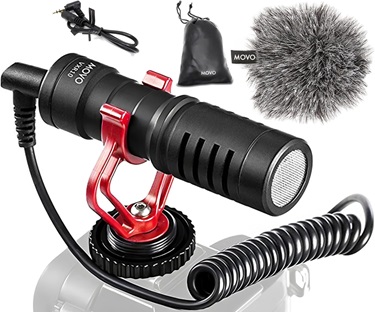
Specifications:
- Compatibility: iPhone, Android, DSLR cameras, camcorders, tablets, laptops
- Connectivity: 3.5mm jack
- Construction: Aluminum
- Special features: Integrated shock mount, “Deadcat” windscreen
- Polar Pattern: Unidirectional
Pros:
- Versatile compatibility with various devices
- Sturdy aluminum construction
- Integrated shock mount minimizes handling noise
- Includes “Deadcat” windscreen for outdoor use
Cons:
- Some issues with the shock mount being fragile
3. Moukey On Camera Mic
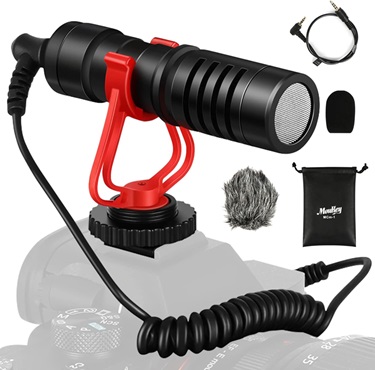
Specifications:
- Compatibility: DSLR cameras, camcorders, smartphones, tablets, laptops
- Connectivity: 3.5mm jack
- Polar Pattern: Unidirectional
- Construction: Aluminum
- Special features: Shock-absorption shock mount, windscreen
- Sensitivity Range: -43±3dB
- Impedance: Max. 0.68KΩ
- Frequency Response: 20-16000 Hz
Pros:
- Universal compatibility with various devices
- High-quality recording with reduced background noise
- Durable aluminum construction
- Shock-absorption shock mount minimizes handling noise
Cons:
- Some issues with durability over time
4. Rode VideoMicPro On Camera Mic
The Rode VideoMic Pro R Camera-Mount Shotgun Microphone is designed for use with camcorders, DSLR cameras, and portable audio recorders. Its goal is to capture clear, high-quality primary and reference audio. With a 1/2″ condenser capsule, it delivers professional-grade sound with low self-noise at just 14dB. The Rycote Lyre shock mounting system reduces external disturbances, minimizing rumble and vibrations. It offers over 70 hours of recording on a single 9V battery, making it reliable for vlogging and other purposes.
Specifications:
- Connectivity Technology: Wired
- Connector Type: 3.5mm Jack
- Special Feature: High-pass filter and three-stage gain control
- Polar Pattern: Unidirectional
- Power Source: 9V battery (over 70 hours use)
- Output: 3.5mm stereo mini-jack
- High Pass Filter: Two-step (flat, 80Hz)
- Level Control: Three-position (-10dB, 0, +20dB)
Pros:
- Clear and directional sound quality
- Lightweight and compact design
- Easy to mount on cameras and boom poles
- Adjustable gain control for versatile recording environments
Cons:
- Some issues with battery overheating and malfunctioning
5. Comica On Camera Mic
The Comica CVM-V30 LITE Video Microphone is a versatile shotgun mic compatible with iPhones, Androids, cameras, camcorders, and similar devices. Its super-cardioid polar pattern minimizes side noise, ensuring crisp audio. Powered by the camera or smartphone, it eliminates the hassle of battery replacements during long recording sessions. The shock mount design reduces vibrations and handling noise for superior sound quality. Whether you’re creating YouTube content or conducting interviews, the Comica CVM-V30 LITE delivers exceptional performance.
Specifications:
- Polar Pattern: Super Cardioid polar pattern
- Frequency Range: 40Hz – 20KHz
- Output Impedance: 2.2kΩ
- Max. SPL: >100dB
- Sensitivity: -34dB±3dB
- Signal to Noise Ratio: >68dB
Pros:
- Easy setup and use for hassle-free recording.
- Versatile compatibility with various devices.
- Effective shock mount minimizes handling noise.
- Super-cardioid polar pattern ensures focused audio capture.
Cons:
- Some issues with performance and compatibility.
6. BOYA On Camera Mic
The Boya MM1 Universal Camera Microphone is a great choice for vloggers. It works with iPhones, Androids, cameras, camcorders, tablets, and laptops. Its high-quality cardioid directional microphone captures clear audio from the front while reducing background noise. Setup is easy – just plug it in and start recording, no batteries needed. Plus, it comes with noise reduction features like a shock mount and furry windshield to minimize unwanted sounds and vibrations, ensuring your recordings sound professional.
Specifications:
- Transducer: Electret Condenser
- Sensitivity: -42dB +/- 1dB / 0dB=1V/Pa, 1kHz
- Signal to Noise Ratio: 76dB SPL
- Plug: 3.5mm TRS and TRRS connector
- Frequency Response: 35-18KHz +/-3dB
- Polar pattern: Cardioid
Pros:
- Universal compatibility with a wide range of devices.
- Clear and crisp sound quality for professional recordings.
- Easy plug-and-play setup without the need for batteries.
- Effective noise reduction features for clear audio capture.
Cons:
- Limited resolution and voice capture quality reported in some situations.
7. Sennheiser On-Camera Mic
The Sennheiser Professional MKE 400 is a reliable companion for your recording needs. Its super-cardioid shotgun design captures and enhances in-camera audio, ensuring your voice stands out. With built-in wind protection and a suspension mount, it minimizes unwanted noise for clear recordings, even in noisy environments. Adjustable low-cut filter and sensitivity options adapt to different shooting situations seamlessly. Compatible with DSLRs, mirrorless cameras, and mobile devices, thanks to interchangeable connectors. Plus, real-time audio monitoring through the headphone output jack ensures consistently professional results.
Specifications:
- Connectivity Technology: Auxiliary
- Connector Type: 3.5mm Jack
- Special Feature: Mute Function, Voice Activated Recording
- Polar Pattern: Unidirectional
- Audio Sensitivity: 35 dB
- Power Source: Two AAA batteries (up to 100 hours)
- Mounting: Cold-shoe mount with quarter-20 thread
- Compatibility: DSLR/M cameras and mobile devices
Pros:
- Exceptional directional sound capture
- Integrated wind protection and shock absorption
- Versatile compatibility with DSLR, mirrorless, and mobile devices
- Intuitive controls for easy adjustments
- Long battery life for extended shooting sessions
- Compact and portable design
Cons:
- Higher self-noise level at maximum gain setting
8. Zoom On Camera Mic
The Zoom F1-SP On-Camera Microphone and Recorder is a versatile tool ideal for filmmakers on the go. Combining a two-channel audio recorder with a single shotgun microphone, it delivers top-notch sound capture. The SGH-6 Shotgun Mic offers precise directional audio, while the F1 records directly onto microSD cards at up to 24-bit/96kHz. Its intuitive controls and compact design suit fast-paced shooting. The redesigned monochrome display ensures easy monitoring in bright sunlight. Plus, its shock mount minimizes handling noise, ensuring consistently professional audio. Perfect for mobile filmmakers, the Zoom F1-SP guarantees high-quality sound in every shot.
Specifications:
- Compatible Devices: Camera
- Hardware Interface: MicroSD, SDHC, Secure Digital Card
- Microphone Form Factor: Shotgun
- Memory Storage Capacity: 32 GB
- Battery Requirement: 2 AAA batteries
- Screen Size: 1.25 inches
- Microphone Operation Mode: Mono
Pros:
- Professional audio quality with hyper-directional shotgun microphone
- Records directly to microSD cards for convenient post-production editing
- Easy-to-use controls for seamless operation in any environment
- Compact and lightweight design perfect for on-the-go shooting
- Specially designed shock mount minimizes handling noise
- Versatile compatibility with various camera setups
Cons:
- LCD and controls placement may hinder visibility when mounted on a tripod
Buying Guide For Best On-Camera Mic
When diving into the world of vlogging, the quality of your audio can significantly impact your content’s overall appeal. Investing in the best on-camera microphone is crucial for capturing clear and engaging audio. To guide you through the process, here are some key factors to consider:
1. Polar Pattern
Why it Matters: The polar pattern of a microphone determines how well it picks up sound from various directions. This is crucial for vloggers, as it affects the clarity and quality of the audio captured, depending on the environment and the type of content being produced.
What to Look For:
- Cardioid Microphones: These are ideal for vlogging, as they primarily pick up sound from the front, minimizing background noise. Perfect for speaking directly to the camera in controlled or moderately noisy environments.
- Supercardioid/Lobar Microphones: For outdoor or specific scenarios where background noise is a concern, supercardioid mics offer a tighter pickup pattern, focusing more on the sound directly in front of the camera while further rejecting side and rear noises.
- Omnidirectional Microphones: These capture sound from all directions and are less common for vlogging. They might be used in scenarios where ambient noise contributes positively to the video’s atmosphere.
2. Compatibility
Why it Matters: Ensuring your microphone is compatible with your recording device (camera, smartphone, etc.) is paramount. An incompatible microphone can limit functionality or, worse, render itself useless for your setup, affecting your vlogging productivity and quality.
What to Look For:
- Connection Type: Check the connection types your camera supports. Most on-camera mics use a 3.5mm jack, but some cameras, especially high-end models, might require different connectors, such as XLR for professional audio equipment.
- Mounting Options: Ensure the microphone can be securely mounted on your camera. Most mics use a standard hot shoe mount, but alternatives or adapters might be needed for certain camera models or smartphones.
- Power Requirements: Some microphones require battery power, while others draw power directly from the camera (plug-in power). Verify what your camera supports and consider the convenience of battery replacements or the reliability of plug-in power for long shoots.
3. Audio Quality
Why it Matters:
Audio quality is pivotal because it directly impacts the viewer’s experience. Clear and rich audio can significantly enhance the storytelling aspect of your vlogs, making them more engaging and professional. Poor audio quality, on the other hand, can distract viewers and detract from the visual content, no matter how high its quality.
What to Look For:
- Low Noise Level: Look for microphones that promise low self-noise or have a high signal-to-noise ratio. This means the microphone will add minimal hiss or hum to your recordings, ensuring clearer audio capture.
- Robust Build Quality: Microphones that are well-built tend to offer better sound isolation and less handling noise, which is crucial when moving your camera around.
- Wind Protection: For outdoor vlogging, ensure the microphone comes with or supports wind protection accessories like foam windscreens or furry windshields to minimize wind noise.
4. Frequency Response
Why it Matters:
The frequency response of a microphone defines the range of sounds it can capture, from the lowest bass to the highest treble. This range determines how well the microphone can reproduce the nuances of human speech and environmental sounds, affecting the naturalness and clarity of your audio.
What to Look For:
- Broad Frequency Range: A wider frequency response range, typically between 20Hz to 20kHz, is ideal as it covers the full spectrum of human hearing.
- Tailored Response Curves: Some microphones offer a frequency response that’s tailored for speech, emphasizing frequencies that enhance voice clarity while de-emphasizing lower and higher frequencies that might not be as relevant.
5. Sensitivity
Why it Matters:
Sensitivity measures how well a microphone converts acoustic pressure into an electrical signal. Higher sensitivity means the microphone can pick up quieter sounds more clearly, which is beneficial in controlled environments but can be a double-edged sword in noisy settings due to the potential capture of unwanted background noise.
What to Look For:
- Appropriate Sensitivity Level: Look for a microphone with a sensitivity that suits your primary filming locations. For instance, a less sensitive microphone might be better for outdoor or noisy environments to avoid capturing too much background noise.
- Adjustable Gain Control: If available, a microphone with adjustable gain control allows you to tweak the sensitivity to suit the recording environment, giving you flexibility and control over the audio capture process.
6. Noise Reduction
Why it Matters:
Noise reduction is essential for ensuring that your recordings are as clear as possible, free from unwanted background noise or interference. This is particularly important in vlogging, where ambient noise can detract from the primary audio content, potentially diminishing the overall quality of your video and distracting your audience.
What to Look For:
- Directional Audio Capture: Microphones with directional pickup patterns (e.g., cardioid, super cardioid) inherently reduce noise by focusing on sound from a specific direction and ignoring others. This is an inherent form of noise reduction.
- Integrated Noise Reduction Technologies: Some microphones come equipped with digital signal processing (DSP) technologies that actively reduce background noise. While useful, it’s important to assess the effectiveness of these technologies, as they can sometimes alter the natural quality of the audio.
- Physical Windshields: For outdoor shooting, microphones with physical windshields (foam covers or furry “deadcats”) can significantly reduce wind noise, which is a common issue in outdoor environments.
7. Impedance
Why it Matters:
Impedance is a measure of resistance a microphone offers to the audio signal. In simple terms, it affects how well the microphone can transfer its audio signal to the recording device (camera, audio recorder, etc.) without loss or interference. Matching the impedance of the microphone with the input device is crucial for maintaining audio quality.
What to Look For:
- Low Impedance: Generally, low-impedance microphones (less than 200 ohms) are preferable for most vlogging applications. They can be used with long cables without significant loss of audio quality, offering versatility in setup and recording.
- Balanced vs. Unbalanced Connections: If available, opt for microphones that offer balanced connections (typically via XLR connectors), as they are less susceptible to noise and can support longer cable runs. However, this might require additional equipment (like an adapter or audio interface) for compatibility with standard camera inputs.
On Camera Mic – FAQs
Ans: No! You have to make sure about the compatibility of the on-camera mic before you choose one. The brands mentioned above have been included with 3.5mm compatibility which makes them a great choice to be used in any device.
Ans: Yes, you can! All you need is to make sure that the mic allows you to use it directly on the DSLR. You have to make sure of the compatibility before buying to enjoy the best usage.
Ans: We have mainly focused on unidirectional polar patterns as such mics have the capability of catching the sound coming from the front. It is great if you have outdoor shoot as they catch less noise from background.
Conclusion
Choosing the perfect mic for vlogging depends on your budget and needs. Here are three top contenders, each catering to different priorities:
- Rode VideoMic Compact: This compact and budget-friendly option provides clear audio with a Rycote Lyre shock mount for minimizing camera vibrations.
- Movo VXR10: This versatile shotgun mic offers compatibility with various cameras, smartphones, and includes a windshield for outdoor shoots.
- Sennheiser MKE 400: This premium choice boasts superior audio quality with a super-cardioid pattern for isolating your voice and features integrated wind protection for reliable outdoor recording.
Remember, the best mic depends on your specific needs and budget. Consider factors like portability, features, and audio quality when making your decision.

